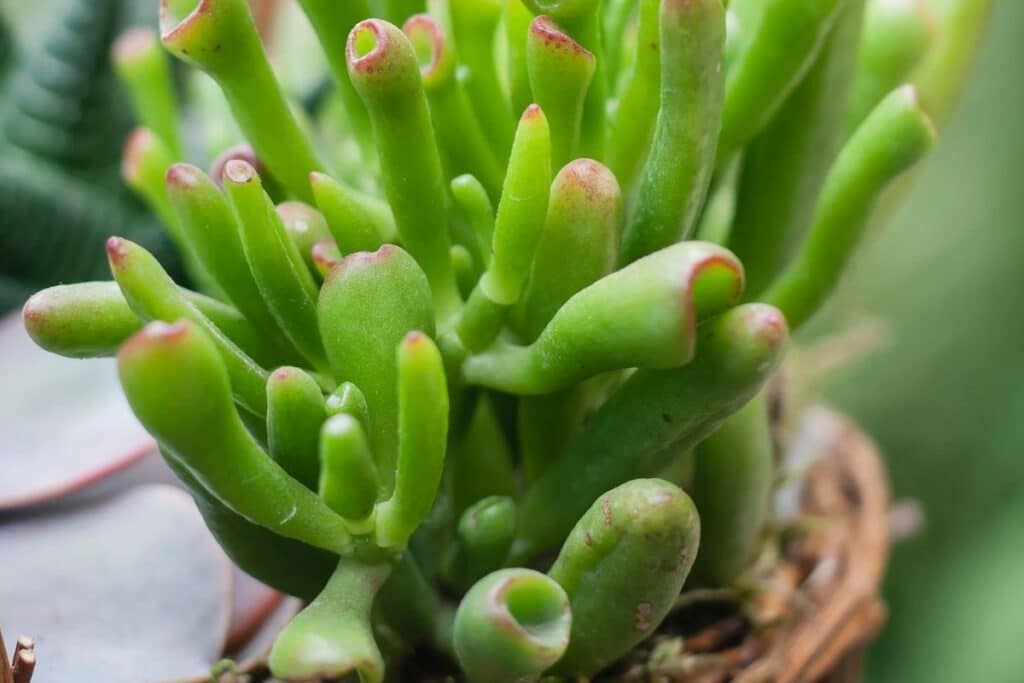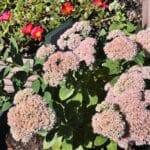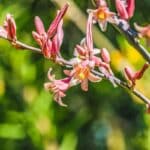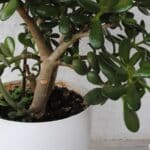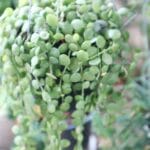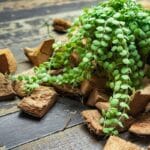If you are a fan of JRR Tolkien’s The Lord of the Rings, Gollum jade may be the right plant for you. This small shrubby succulent is so weirdly beautiful with long finger-like appearance. It is the perfect succulent plant to have if you prefer one that is low maintenance, yet beautiful.
Read on to know more about this strange plant and how to take care of it.
What is a Gollum Jade Plant?
Gollum jade is a fun and strange variety of the infamous jade plant. It is part of the Tolkien group of Crassula ovata along with another peculiar plant called ‘Hobbit’ (1).
Named after the monstrous character from The Lord of The Rings, Gollum jade features long, green, tubular leaves with puckering tips, like a trumpet. They curl up like frail bony fingers searching for the ‘One Ring’. When placed in bright light, the leaves take on a pinkish hue at the tips. And like Gollum, they are also small, only growing up to 3-ft in height (1, 2).
The deviation of Gollum jade from the usual appearance of a jade plant is said to be the result of a mutation caused by a bacterium called mycoplasma. The mutation causes the flat leaves of a normal jade plant to curl in on itself and fuse together, forming its distinct tubular appearance (1).
Gollum jade is also known as green trumpet jade or green coral jade.
In the correct conditions, mature gollum jade plants (at least three years old) can blossom with small, star shaped flowers during late fall and early winter.

Gollum Jade Care Guide
Gollum jade plants are very easy to care for. The caring need of Gollum jade is just like that of the typical jade plant which are known to be forgiving plants. They can thrive well even if you neglect them for a couple of days.
Light Conditions
Make sure your Gollum Jade gets enough light to encourage blooming.
Gollum jade can flourish in full sun to partial shade. Much like its cave-dwelling namesake, it can tolerate full shade and can survive darkness, but it will take on a darker green color.
To achieve vibrant colors, place them in brightly lit areas where they can receive plenty of indirect light. When growing indoors, an east facing window will work best.
When growing outdoors, be careful not to place your plants under direct sunlight, especially in the afternoon, as it can burn the fleshy leaves (2,3).
Water
Gollum jade can tolerate mild drought conditions and can bounce back to life if you miss a few waterings (3). So, when it comes to watering, it is better to stumble on the underwatered side than the overwatered side. Overwatering can cause root rot, which there is no bouncing back from.
The watering needs of Gollum jade will depend on the climate and seasons in your area. In warm climates, Gollum jades will need watering as often as every week. In cooler months, you might need to cut back on watering every other week.
During winter, watering may be cut back to every 2-3 weeks or completely held off. It really depends on how fast the potting soil dries. In general, succulents will require watering when the top layer of the potting soil is completely dry to the touch (2,3).
Temperature and humid conditions

Although they can tolerate mild frost, Gollum jade is not cold hardy and can only tolerate down to 28oF. They are not heat tolerant either and will even burn if left under the intense afternoon sun. For best results, succulents like Gollum jade must be kept in warm temperatures between 45-85oF
Gollum jade also prefers low to average room humidity. Keep them in areas with good air circulation and avoid misting.
Potting/Growing Media
When it comes to potting media, Gollum jade prefers a porous, well-drained soil to avoid overwatering. The commercial potting mix for cactus and succulents will do, but if you prefer to make potting soil for jade plant, you can combine a 2:1 potting soil and coarse sand, or 1:1:1 potting soil, perlite, and sand (2,3).
Fertilizer
Although not necessary, feeding Gollum jade plants can help them get the nutrients they need to grow beautifully. Feeding is best done during the growing season (spring and summer months). Feed your plants with half strength balanced fertilizer or one that is specially formulated for cacti and succulents every 2 weeks.
Pruning
As your Gollum jade grows, the finger-like leaves will weigh your plant down. Although these plants can prune themselves by shedding some of gollum jade’s leaves, pruning your Crassula ovata Gollum jade will also help remove the extra weight.
Pruning can be done any time of the year if you think it is needed, but it is best to do it in spring or summer when your plant is actively growing.
How to Propagate Gollum Jade
Propagating Gollum jade plants is easily done through leaf or stem cuttings. To do so, just obtain a leaf or a stem section with at least two leaf nodes from a healthy plant. Place your cuttings in a warm, dry place and let it form a callous.
Once your cuttings have developed roots, you can stick them up in a pot with succulent mix and water them. From here on out, take care of your new Crassula Ovata Hobbit until they are established.
Gollum jade plants can also propagate on their own when they shed their leaves.
Common pests and diseases
Gollum jade (Crassula ovata ‘Gollum’) is generally a hardy succulent, but it can be susceptible to a few pests and diseases. Common pests include mealybugs, aphids, and spider mites, which may infest the plant and cause damage if not addressed promptly.
Additionally, overwatering or poor soil drainage can lead to root rot, a fungal disease that affects the roots and can result in the decline of the plant.
Regularly inspecting the Gollum jade for signs of pests, maintaining proper watering practices, and providing well-draining soil can help prevent and mitigate these issues.
Toxicity
Gollum jade is one of those poisonous succulents that can be toxic to humans and pets. Skin contact with the sap can cause irritation while ingestion of all parts of the plants can cause vomiting and diarrhea. So, keep them away from your pets and make sure to wear gloves when propagating them.
If you love succulents, check out more varieties you can grow on this page https://florgeous.com/types-of-succulents/
FAQs
Is Gollum Jade rare?
Gollum Jade (Crassula ovata ‘Gollum’) is not considered rare. It is a cultivar of the common jade plant, also known as the “Hobbit” jade due to its unique tubular leaves.
How much sunlight does a Gollum jade plant need?
Gollum Jade plants prefer bright, indirect light but can tolerate some direct sunlight. Providing them with about 4-6 hours of indirect sunlight per day is ideal.
Is Gollum Jade poisonous?
Jade plants, including Gollum Jade, are considered mildly toxic to pets if ingested. It’s advisable to keep them out of reach of animals.
Can jade plant survive without direct sunlight?
Jade plants can tolerate some shade but generally thrive in bright, indirect sunlight. While they can survive with less light, it may affect their growth and appearance. Providing some direct sunlight or supplementing with artificial light can help maintain a healthy and well-shaped jade plant.
Final thoughts
In conclusion, Gollum jade (Crassula ovata ‘Gollum’) is a low maintenance plant and a great addition to any indoor or outdoor garden. With its distinctive tubular leaves and tolerance for various conditions, it makes for a low-maintenance and visually appealing plant.
Proper care, including well-draining soil, moderate watering, and occasional pruning, will ensure the health and longevity of your gollum jade plant.
Whether you’re a beginner or an experienced succulent enthusiast, cultivating this distinctive variety can be a rewarding and enjoyable experience.
References
Reference list
(1) Mottram R. “Crassula ovata: Tolkien Group“. Crassulaceae No. 2. International Crassulaceae Network. 2013. PP. 1-5.
(2) Bognasco J., Riedmuller B. “Succulents: Choosing, Growing, and Caring for Cactuses and other Succulents“. Cool Springs Press. 2019. P. 125
(3) Neal N. “Gardener’s Guide to Tropical Plants: Cool Ways to Add Hot Colors, Bold Foliage, and Striking Textures”. Cool Springs Press. 2013. P. 124.
Close
Image by depositphotos.com/jessicahyde

